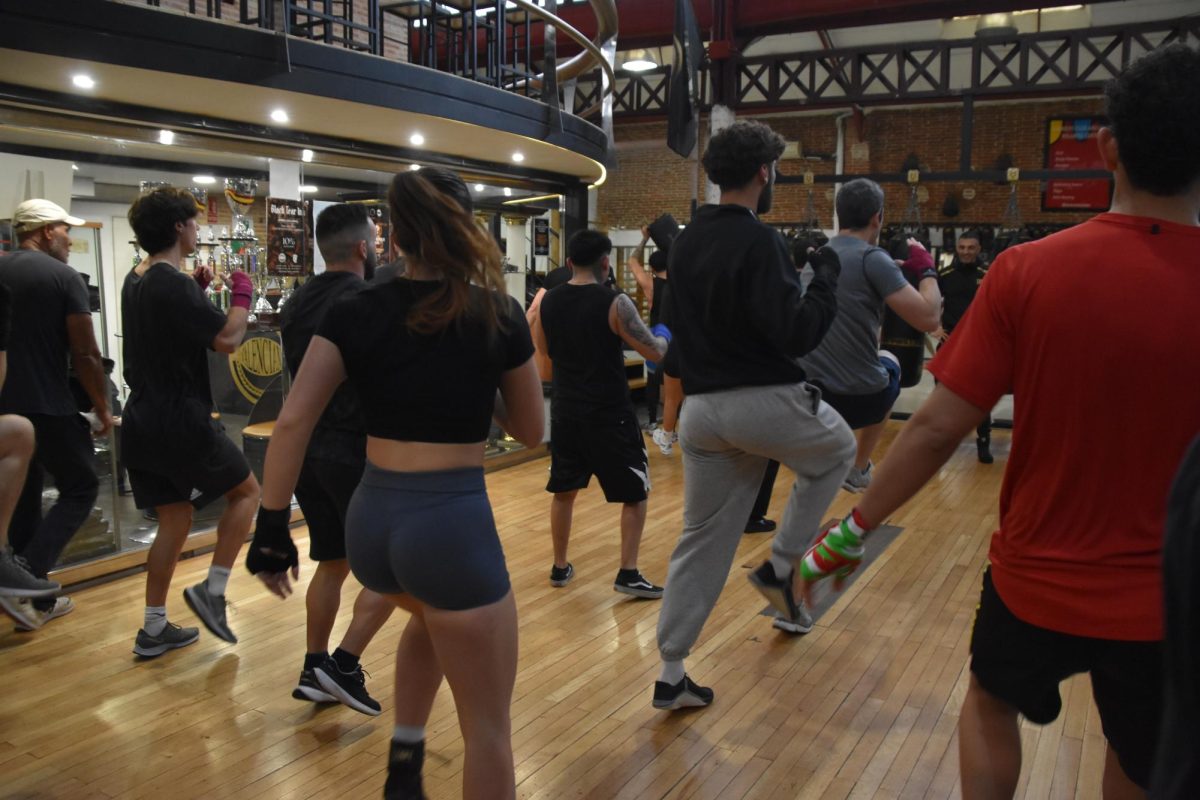
Britney Saras
Exercisers warm up before a boxing class at Club Deportivo José Valenciano, which also has a boxing ring, in the Chamberí neighborhood.
A dark room is filled with individuals of various ages and backgrounds, but all eyes are locked on a dimly-lit podium. A remix of an American 2010’s anthem blasts loudly enough to muffle the sound of wheels spinning and the strong exhales of cyclists. Sporting an all-black outfit and an infectious energy, instructor Camilia Toro yells at the room: “Vamos Síclo!”
Toro is a young instructor at the popular spin studio Síclo, which opened in 2019 in the Justicia district of Madrid. It’s one of many workout studios that have popped up in Madrid in the last 10 years. While it’s not yet quite the same as New York or other large cities, where every block has a fitness studio, Madrid’s workout culture is evolving to include boutique offerings, from barre classes to spin studios like Síclo, accompanied by a surge in brand-name activewear.
“I think workout classes have become such a culture in the US, and people start their day with a Pilates class or going to the gym,” says Lella Anders, a native New Yorker who is studying at IE University in Madrid.
She has noticed a change in Spain’s fitness culture.
“A lot more people are getting into the trend of workout classes.”
Síclo, a Mexican chain, was a pioneer in Madrid, opening when the European market for group fitness classes was relatively unsaturated.
“It all started with Síclo, then Tracy Anderson and then Casa Barré, and now there is even Orange Theory,” says Carla Legorburu, an employee at Casa Barré in Madrid.
Casa Barré has become one of the most popular locations for barre classes since opening in September of 2021. More and more studios have opened in Malasaña and Salamanca, but the customers come from all over the city.
Legorburu has seen a large movement towards group fitness classes over the last 5 years.
“It is definitely new, but I think Spanish people have started to adopt it because it is new… and it is liked more,” she said.
The studios attract young professionals, moms and students – all willing to spend 20 or more euros for a drop-in class.
Eva Zanner works at Lululemon in Madrid and can see people’s preferences in workout attire firsthand. Lululemon is a Canadian athletic apparel company that is highly popular in the United States, but Zanner said that young people in Madrid have been flocking to Lululemon since its opening in late 2022.
“The customers like to buy things for Pilates and barre,” she says.
While Madrid is full of parks and gyms, “many more people have been liking classes.”
Madrid’s residents are embracing group fitness in full force, not entirely due to a younger generation. Both Zanner and Legorburu note that their customers are of all ages, and that the desire for working out has been fulfilled more through classes than through a gym or a walk in the park.
Zanner states that because “we are in the young area,” Lululemon sees more and more young customers. However, older clients will still come and ask for recommendations on which clothing will best suit their workout class needs.
Not only have fitness classes become more of a cult following, but the city’s residents have also taken more of an interest in overall health and wellness. Lamarca Well, a wellness store in Madrid, opened with the intention of helping customers lead “an active, healthy, and conscious life.” The store features countless health products, from health foods to supplements to sleep needs – and it is conveniently located across the street from Síclo and next to the famed Tracy Anderson workout studio.
While customers’ intentions of workout and health might have changed in the last couple of years, it seems that the city’s residents have no intention of changing how exercise affects their fashion.
Legorburu explains that Casa Barré customers have no intention of walking around in workout clothes after one of their intense classes.
“They come early, change, workout, change again, and then go,” she says.
Fitness studios in Madrid have enabled their customers to put appearance first. Many of them have large locker rooms with showers and beauty products.
In the streets of Madrid, streetwear style is visibly different than that of the United States. Madrid lacks loungewear and exercise clothes.
“There is more pressure to dress up in Madrid,” says Anders.
Zanner explains that the city’s residents still like to look put together, and certain items at Lululemon portray that more than others.
“Leggings are the most popular for women, and no one buys shorts. Even in the summer if it is warm, very few people like to wear shorts,” she says.
Even Ally Hammond, a United States native that has been studying in Madrid, wants to stay away from athleisure. Similar to those attending Síclo or Casa Barré, she doesn’t let attending fitness classes influence her fashion choices.
“I have adjusted to the lifestyle now,” she explains.
It’s a lifestyle that does not consist of grocery shopping in her Lululemon shorts.
Madrid has embarked on a journey that popularizes workout classes and group fitness. However, it is unwilling to compromise its wardrobe.
As Legorburu said, “I think that it will stay for a while – that type of shift is more of a cultural shift and not a fashion shift.”